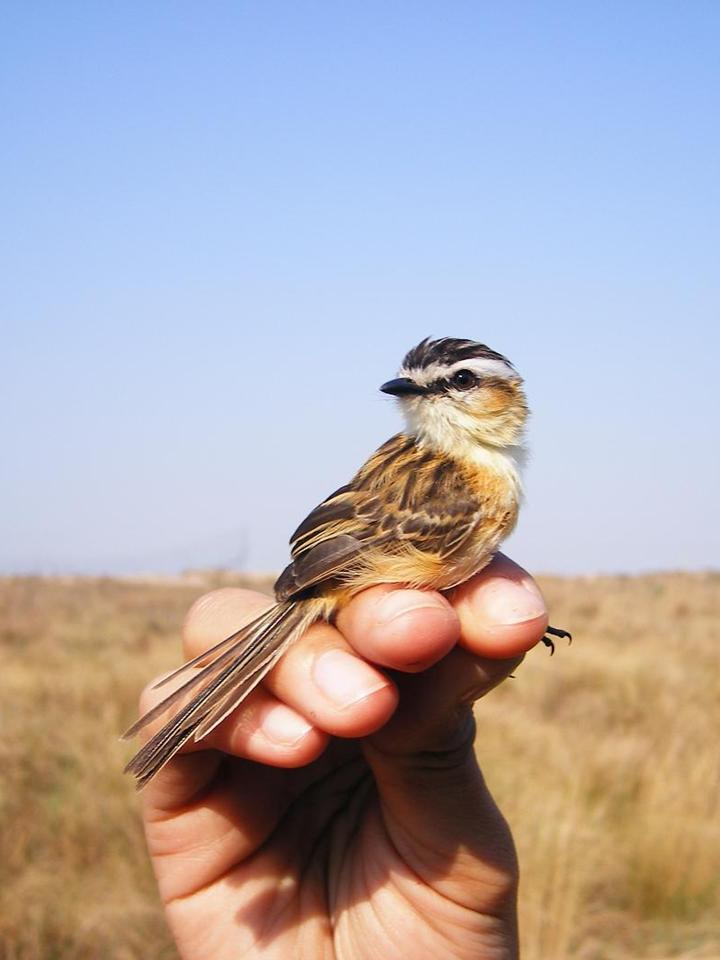APPENDIX A: SPECIES LIST FOR ESTANCIA LAGUNA BLANCA
Column Key 1 = Species Recorded During Project; 2 = Species Trapped During Project; 3 = Endemic Species; 4 Migrant Species; 5 = Global Conservation Status; 6 = National Conservation Status.
Symbol Key: R = Recorded During November Project; V = Recorded By Voice During November Project; T = Trapped; AF = Atlantic Forest Endemic; CE = Cerrado Endemic; MG = Mesopotamian Grasslands Endemic; M = Migrant Species;
1. Rhea americana - Greater Rhea - R
2. Crypturellus undulatus - Undulated Tinamou - R
3. Crypturellus parvirostris - Small-billed Tinamou - R
4. Crypturellus tataupa - Tataupa Tinamou - R
5. Rhynchotus rufescens - Red-winged Tinamou - R
6. Nothura minor - Lesser Nothura - R CE
7. Nothura maculosa - Spotted Tinamou - R
8. Tachybaptus dominicus - Least Grebe
9. Podilymbus podiceps - Pied-billed Grebe
10. Phalacrocorax brasilianus - Neotropical Cormorant - R
11. Anhinga anhinga - Anhinga
12. Tigrisoma lineatum - Rufescent Tiger-heron
13. Syrigma sibilatrix - Whistling Heron - R
14. Ardea alba - Great Egret - R
15. Egretta thula - Snowy Egret
16. Bubulcus ibis - Cattle Egret - R
17. Butorides striata - Striated Heron - R
18. Nycticorax nycticorax - Black-crowned Night-heron - R
19. Ciconia maguari - Maguari Stork - R
20. Phimosus infuscatus - Bare-faced Ibis
21. Theristicus caudatus - Buff-necked Ibis - R
22. Platalea ajaja - Roseate Spoonbill - R
23. Dendrocygna viduata - White-faced Whistling-duck - R
24. Netta peposaca - Rosybill - R
25. Amazonetta brasiliensis - Brazilian Duck - R
26. Nomonyx dominicus - Masked Duck - R
27. Coragyps atratus - Black Vulture - R
28. Cathartes aura - Turkey Vulture - R
29. Cathartes burrovianus - Lesser Yellow-headed Vulture - R
30. Sarcoramphus papa - King Vulture - R
31. Pandion haliaetus - Osprey - R M
32. Elanoides forficatus - Swallow-tailed Kite - R M
33. Gampsonyx swainsonii - Pearl Kite - R
34. Elanus leucurus - White-tailed Kite
35. Harpagus diodon - Rufous-thighed Kite - R
36. Chondrohierax uncinctus - Hook-billed Kite - R
37. Rostrhamus sociabilis - Snail Kite - R M
38. Ictinia plumbea - Plumbeous Kite - R M
39. Circus buffoni - Long-winged Harrier - R
40. Geranospiza caerulescens - Crane Hawk
41. Buteogallus meridionalis - Savanna Hawk - R
42. Harpyhaliaetus coronatus - Crowned Eagle
43. Buteo magnirostris - Roadside Hawk - R
44. Buteo albicaudatus - White-tailed Hawk - R
45. Buteo albonotatus - Zone-tailed Hawk - R
46. Spizastur melanoleucus - Black-and-white Hawk-eagle
47. Caracara plancus - Southern Crested-caracara - R
48. Milvago chimachima - Yellow-headed Caracara - R
49. Milvago chimango - Chimango Caracara - R
50. Herpetotheres cachinnans - Laughing Falcon
51. Falco sparverius - American Kestrel - R
52. Falco femoralis - Aplomado Falcon - R
53. Falco rufigularis - Bat Falcon
54. Penelope superciliaris - Rusty-margined Guan - R
55. Aramides cajanea - Gray-necked Wood-rail - R
56. Aramides ypecaha - Giant Wood-rail
57. Aramides saracura - Slaty-breasted Wood-rail - AF
58. Porzana albicollis - Ash-throated Crake - R
59. Pardirallus sanguinolentus - Plumbeous Rail
60. Porphyrio martinica - American Purple Gallinule - R M
61. Porphyrio flavirostris - Azure Gallinule - R M
62. Cariama cristata - Red-legged Seriema - R
63. Vanellus chilensis - Southern Lapwing - R
64. Pluvialis dominica - American Golden-Plover
65. Charadrius collaris - Collared Plover
66. Himantopus melanurus - White-backed Stilt - R
67. Jacana jacana - Wattled Jacana - R
68. Tringa melanoleuca - Greater Yellowlegs - R M
69. Tringa solitaria - Solitary Sandpiper - R M
70. Actitis macularius - Spotted Sandpiper - R M
71. Bartramia longicauda - Upland Sandpiper - R M
72. Calidris fuscicollis - White-rumped Sandpiper - R M
73. Gallinago paraguaiae - South American Snipe
74. Sterna superciliaris - Yellow-billed Tern - R
75. Rynchops niger - Black Skimmer - R
76. Patagioenas picazuro - Picazuro Pigeon - R M
77. Patagioenas cayennensis - Pale-vented Pigeon - R
78. Zenaida auriculata - Eared Dove - R
79. Columbina talpacoti - Ruddy Ground-dove - R T
80. Columbina picui - Picui Ground-dove - R T
81. Scardafella squammata - Scaled Dove - R T
82. Claravis pretiosa - Blue Ground-dove - R
83. Leptotila verreauxi - White-tipped Dove - R
84. Ara chloropterus - Red-and-green Macaw
85. Aratinga leucophthalmus - White-eyed Parakeet - R
86. Aratinga aurea - Peach-fronted Parakeet - R
87. Pyrrhura frontalis - Reddish-bellied Parakeet - R AF
88. Myiopsitta monachus - Monk Parakeet - R
89. Brotogeris chiriri - Yellow-chevroned Parakeet - R
90. Pionopsitta pileata - Pileated Parrot - R
91. Pionus maximiliani - Scaly-headed Parrot - R
92. Amazona aestiva - Turquoise-fronted Amazon - R
93. Coccyzus melacoryphus - Dark-billed Cuckoo - R T M
94. Piaya cayana - Squirrel Cuckoo - R
95. Tapera naevia - Striped Cuckoo
96. Crotophaga major - Greater Ani - R M
97. Crotophaga ani - Smooth-billed Ani R
98. Guira guira - Guira Cuckoo R
99. Megascops choliba - Tropical Screech-owl - R
100. Glaucidium brasilianum - Ferruginous Pygmy-owl - R
101. Athene cunicularia - Burrowing Owl - R
102. Asio flammeus - Short-eared Owl
103. Lurocalis nattereri - Chestnut-banded Nighthawk - R
104. Podager nacunda - Nacunda Nighthawk - R M
105. Nyctidromus albicollis - Common Pauraque - R T
106. Caprimulgus rufus - Rufous Nightjar - R
107. Caprimulgus parvulus - Little Nightjar - R T
108. Hydropsalis torquata - Scissor-tailed Nightjar - R T
109. Eleothreptus candicans - White-winged Nightjar - R T CE
110. Nyctibius griseus - Common Potoo - R T
111. Chaetura meridionalis - Sick's Swift - R M
112. Phaethornis eurynome - Scale-throated Hermit - V AF
113. Chlorostilbon aureoventris - Glittering-bellied Emerald
114. Hylocharis chrysura - Gilded Sapphire - R T
115. Leucochloris albicollis - White-throated Hummingbird - AF
116. Polytmus guainumbi - White-tailed Goldenthroat - R
117. Heliomaster furcifer - Blue-tufted Starthroat
118. Trogon surrucura - Surucua Trogon - R AF
119. Trogon rufus - Black-throated Trogon - V
120. Baryphthengus ruficapillus - Rufous-capped Motmot - R AF
121. Ceryle torquatus - Ringed Kingfisher - R
122. Chloroceryle amazona - Amazon Kingfisher
123. Chloroceryle americana - Green Kingfisher
124. Notharchus swainsoni - Buff-bellied Puffbird - R AF
125. Nystalus chacuru - White-eared Puffbird - R
126. Nystalus maculatus - Spot-backed Puffbird - R
127. Pteroglossus castanotis - Chestnut-eared Aracari - R
128. Ramphastos dicolorus - Red-breasted Toucan - AF
129. Ramphastos toco - Toco Toucan - R
130. Picumnus cirratus - White-barred Piculet - R
131. Melanerpes candidus - White Woodpecker - R
132. Veniliornis passerinus - Little Woodpecker - R
133. Colaptes melanochloros - Green-barred Woodpecker - R
134. Colaptes campestris - Campo Flicker - R
135. Celeus lugubris - Pale-crested Woodpecker
136. Celeus flavescens - Blonde-crested Woodpecker - R
137. Dryocopus lineatus - Lineated Woodpecker - R
138. Dryocopus galeatus - Helmeted Woodpecker - R AF
139. Campephilus robustus - Robust Woodpecker - V AF
140. Sittasomus griseicapillus - Olivaceous Woodcreeper
141. Xiphocolaptes albicollis - White-throated Woodcreeper - R
142. Dendrocolaptes platyrostris - Planalto Woodcreeper - R
143. Lepidocolaptes angustirostris - Narrow-billed Woodcreeper - R
144. Furnarius rufus - Rufous Hornero - R
145. Synallaxis ruficapilla - Rufous-capped Spinetail - R AF
146. Synallaxis frontalis - Sooty-fronted Spinetail - R
147. Synallaxis albescens - Pale-breasted Spinetail - R T
148. Certhiaxis cinnamomeus - Yellow-chinned Spinetail - R
149. Phacellodomus ruber - Greater Thornbird
150. Philydor lichtensteini - Ochre-breasted Foliage-gleaner - R AF
151. Taraba major - Great Antshrike
152. Thamnophilus caerulescens - Variable Antshrike - R
153. Dysithamnus mentalis - Plain Antvireo - R
154. Herpsilochmus atricapillus - Black-capped Antwren - R
155. Formicivora rufa - Rusty-backed Antwren - R T
156. Conopophaga lineata - Rufous Gnateater - AF
157. Camptostoma obsoletum - Southern Beardless-tyrannulet - R T
158. Phaeomyias murina - Mouse-colored Tyrannulet - M
159. Capsiempis flaveola - Yellow Tyrannulet
160. Suiriri suiriri - Suiriri Flycatcher - R
161. Myiopagis caniceps - Gray Elaenia - R
162. Myiopagis viridicata - Greenish Elaenia
163. Elaenia flavogaster - Yellow-bellied Elaenia - R T
164. Elaenia spectabilis - Large Elaenia - M
165. Elaenia albiceps - White-crested Elaenia - R M
166. Elaenia parvirostris - Small-billed Elaenia - R T M
167. Elaenia chiriquensis - Lesser Elaenia R T
168. Elaenia obscura - Highland Elaenia
169. Serpophaga nigricans - Sooty Tyrannulet
170. Serpophaga subcristata - White-crested Tyrannulet - R M
171. Serpophaga munda - White-bellied Tyrannulet M
172. Culicivora caudacuta - Sharp-tailed Grass-tyrant - R
173. Polystictus pectoralis - Bearded Tachuri - M
174. Euscarthmus meloryphus - Tawny-crowned Pygmy-tyrant - R T
175. Leptopogon amaurocephalus - Sepia-capped Flycatcher - R
176. Myiornis auricularis - Eared Pygmy-tyrant - R AF
177. Hemitriccus margaritaceiventer - Pearly-vented Tody-tyrant - R T
178. Platyrinchus mystaceus - White-throated Spadebill
179. Myiophobus fasciatus - Bran-colored Flycatcher - R T M
180. Lathrotriccus euleri - Euler’s Flycatcher - M
181. Contopus cinereus - Tropical Pewee
182. Cnemotriccus fuscatus - Fuscous Flycatcher - R T M
183. Pyrocephalus rubinus - Vermilion Flycatcher - R M
184. Xolmis cinereus - Gray Monjita
185. Xolmis velata - White-rumped Monjita - R
186. Arundinicola leucocephala - White-headed Marsh-tyrant
187. Colonia colonus - Long-tailed Tyrant
188. Alectrurus tricolor - Cock-tailed Tyrant - R
189. Gubernetes yetapa - Streamer-tailed Tyrant - R
190. Satrapa icterophrys - Yellow-browed Tyrant - R
191. Machetornis rixosa - Cattle Tyrant - R
192. Casiornis rufus - Rufous Casiornis - R T
193. Sirystes sibilator - Eastern Sirystes - R
194. Myiarchus swainsoni - Swainson’s Flycatcher - R M
195. Myiarchus ferox - Short-crested Flycatcher - R T
196. Myiarchus tyrannulus - Brown-crested Flycatcher - R T
197. Pitangus sulphuratus - Great Kiskadee - R T
198. Megarynchus pitangua - Boat-billed Flycatcher - R
199. Myiozetetes similis - Social Flycatcher - R T
200. Conopias trivirgatus - Three-striped Flycatcher
201. Myiodynastes maculatus - Streaked Flycatcher - R M
202. Empidonomus aurantioatrocristatus - Crowned Slaty-flycatcher - R M
203. Tyrannus melancholicus - Tropical Kingbird - R M
204. Tyrannus savana - Fork-tailed Flycatcher - R M
205. Pachyramphus viridis - Green-backed Becard
206. Pachyramphus validus - Crested Becard - R
207. Tityra cayana - Black-tailed Tityra - R
208. Tityra semifasciata - Masked Tityra - R
209. Tityra inquisitor - Black-crowned Tityra - R
210. Schiffornis virescens - Greenish Schiffornis - R AF
211. Pyroderus scutatus - Red-ruffed Fruitcrow - R AF
212. Procnias nudicollis - Bare-throated Bellbird - V AF
213. Cyanocorax cyanomelas - Purplish Jay - R
214. Cyanocorax cristatellus - Curl-crested Jay - R CE
215. Cyanocorax chrysops - Plush-crested Jay - R
216. Tachycineta leucorrhoa - White-rumped Swallow - R M
217. Progne tapera - Brown-chested Martin - R M
218. Progne chalybea - Grey-breasted Martin - R M
219. Alopochelidon fucata - Tawny-headed Swallow - R
220. Stelgidopteryx ruficollis - Southern Rough-wing Swallow - M
221. Riparia riparia - Sand Martin - M
222. Hirundo rustica - Barn Swallow - R M
223. Petrochelidon pyrrhonota - Cliff Swallow - R M
224. Donacobius atricapilla - Donacobius
225. Campylorhynchus turdinus - Thrush-like Wren - V
226. Troglodytes aedon - House Wren - R T
227. Turdus rufiventris - Rufous-bellied Thrush
228. Turdus leucomelas - Pale-breasted Thrush - R T
229. Turdus amaurochalinus - Creamy-bellied Thrush
230. Mimus saturninus - Chalk-browed Mockingbird - R
231. Mimus triurus - White-banded MockingbirdM
232. Anthus lutescens - Yellowish Pipit - R
233. Vireo olivaceus - Red-eyed Vireo - M
234. Cyclarhis gujanensis - Rufous-browed Peppershrike - R
235. Parula pitiayumi - Tropical Parula
236. Geothlypis aequinoctialis - Masked Yellowthroat - V
237. Basileuterus flaveolus - Flavescent Warbler - R
238. Basileuterus culicivorus - Golden-crowned Warbler - R
239. Conirostrum speciosum - Chestnut-vented Conebill - R
240. Pipraeidea melanonota - Fawn-breasted Tanager
241. Tangara cayana - Burnished-buff Tanager - R
242. Dacnis cayana - Blue Dacnis - R T
243. Euphonia chlorotica - Purple-throated Euphonia - R T
244. Euphonia violacea - Violaceous Euphonia
245. Euphonia pectoralis - Chestnut-bellied Euphonia - AF
246. Thraupis sayaca - Sayaca Tanager - R T
247. Tachyphonus coronatus - Ruby-crowned Tanager - AF
248. Cypsnagra hirundinacea - White-rumped Tanager - R T
249. Pyrrhocoma ruficeps - Chestnut-headed Tanager - AF
250. Nemosia pileata - Hooded Tanager - R
251. Hemithraupis guira - Guira Tanager
252. Neothraupis fasciata - White-banded Tanager - R T
253. Cissopis leveriana - Magpie Tanager - R
254. Saltator atricollis - Black-throated Saltator - R T CE
255. Coryphospingus cucullatus - Red-crested Finch - R T
256. Coryphaspiza melanotis - Black-masked Finch - R
257. Oryzoborus angolensis - Lesser Seed-finch
258. Sporophila plumbea - Plumbeous Seedeater - R
259. Sporophila collaris - Rusty-collared Seedeater
260. Sporophila caerulescens - Double-collared Seedeater R T
261. Sporophila leucoptera - White-bellied Seedeater - R T
262. Sporophila bouvreuil - Capped Seedeater - M
263. Sporophila hypoxantha - Tawny-bellied Seedeater - R T
264. Sporophila ruficollis - Dark-throated Seedeater - R M
265. Sporophila palustris - Marsh Seedeater - R MG M
266. Sporophila cinnamomea - Chestnut Seedeater - R MG M
267. Volatinia jacarina - Blue-black Grassquit - R T
268. Embernagra platensis - Great Pampa-finch
269. Emberizoides herbicola - Wedge-tailed Grass-finch - R T
270. Ammodramus humeralis - Grassland Sparrow - R T
271. Zonotrichia capensis - Rufous-collared Sparrow
272. Molothrus bonariensis - Shiny Cowbird - R
273. Molothrus rufoaxillaris - Screaming Cowbird - R
274. Molothrus oryzivorus - Giant Cowbird - R
275. Cacicus haemorrhous - Red-rumped Cacique - R
276. Gnorimopsar chopi - Chopi Blackbird - R T
277. Agelasticus cyanopus - Unicolored Blackbird
278. Chrysomus ruficapillus - Chestnut-capped Blackbird - R
279. Icterus cayanensis - Epaulet Oriole - R
280. Pseudoleistes guirahuro - Yellow-rumped Marshbird
281. Sturnella superciliaris - White-browed Blackbird
282. Carduelis magellanica - Hooded Siskin
APPENDIX B: CONSERVATION STATUS OF BIRDS OF ESTANCIA LAGUNA BLANCA
The following is a list of the 47 species of conservation concern that occur at Estancia Laguna Blanca, giving their global conservation status in italics (3 EN, 7 VU and 4 NT) and conservation status within Paraguay (1 CR, 5 EN, 11 VU and 30 NT). The designations and criteria used to define them follow Birdlife International.
The following abbreviations are used CR = Critical, EN= Endangered, VU = Vulnerable, NT = Near Threatened.
Greater Rhea - Rhea americana - NT - NT - A2c, d; A3c, d
Lesser Nothura - Nothura minor - VU - CR - A2c, A2d; B1a, Bab(iii)
King Vulture - Sarcoramphus papa - LC - NT - A2c, A3c
Swallow-tailed Kite - Elanoides forficatus - LC - NT - A2c; A3c
Rufous-thighed Kite - Harpagus diodon - LC - NT - A2c; A3c
Crowned Eagle - Harpyhaliaetus coronatus - EN - VU - D1
Rusty-margined Guan - Penelope superciliaris - LC - NT - A2c,d; A3c,d
Slaty-breasted Wood-rail - Aramides saracura - LC - NT - A2c; A3c
Upland Sandpiper - Bartramia longicauda - LC - NT - A2c; A3c
Red-and-green Macaw - Ara chloropterus - LC - VU - C2ai
Pileated Parrot - Pionopsitta pileata - LC - NT - A2cd; A3c
Turquoise-fronted Amazon - Amazona aestiva - LC - NT - A2d, A3d
White-winged Nightjar - Eleothreptus candicans - EN - EN - C2ai
Scale-throated Hermit - Phaethornis eurynome - LC - NT - A2c; A3c
White-tailed Goldenthroat - Polytmus guainumbi - LC - NT - A2c; A3c
Black-throated Trogon - Trogon rufus - LC - NT - A2c; A3c
Buff-bellied Puffbird - Notharchus swainsoni - LC - NT - A2c; A3c
Red-breasted Toucan - Ramphastos dicolorus - LC - NT - A2c; A3c
Blonde-crested Woodpecker - Celeus flavescens - LC - NT - A2c; A3c
Helmeted Woodpecker - Dryocopus galeatus - VU - VU - A2c; A3c
White-throated Woodcreeper - Xiphocolaptes albicollis - LC - NT - A2c; A3c
Rufous-capped Spinetail - Synallaxis ruficapilla - LC - NT - A2c; A3c
Rusty-backed Antwren - Formicivora rufa - LC - NT - A2c; A3c
Rufous Gnateater - Conopophaga lineata - LC - NT - A2c; A3c
Yellow Tyrannulet - Capsiempis flaveola - LC - NT - A2c; A3c
Sharp-tailed Grass-tyrant - Culicivora caudacuta - VU - VU - A2c; A3c
Bearded Tachuri - Polystictus pectoralis - NT - NT - A2c; A3c
White-throated Spadebill - Platyrinchus mystaceus - LC - NT - A2c; A3c
Tropical Pewee - Contopus cinereus - LC - NT - A2c; A3c
White-rumped Monjita - Xolmis velata - LC - NT - A2c; A3c
Cock-tailed Tyrant - Alectrurus tricolor - VU - EN - C2a(I)
Three-striped Flycatcher - Conopias trivirgatus - LC - NT - A2c, A3c
Masked Tityra - Tityra semifasciata - LC - VU - A2c, A3c
Greenish Schiffornis - Schiffornis virescens - LC - VU - A2c, A3c
Red-ruffed Fruitcrow - Pyroderus scutatus - LC - VU - A2c, A3c
Bare-throated Bellbird - Procnias nudicollis - VU - EN - A2c, d, A3c, d;
Curl-crested Jay - Cyanocorax cristatellus - LC - VU - A2c, A3c
Violaceous Euphonia - Euphonia violacea - LC - NT - A2c, A3c
Chestnut-bellied Euphonia - Euphonia pectoralis - LC - NT - A2c, A3c
White-rumped Tanager - Cypsnagra hirundinacea - LC - VU - A2c, A3c
Chestnut-headed Tanager - Pyrrhocoma ruficeps - LC - NT - A2c, A3c
White-banded Tanager - Neothraupis fasciata - NT - VU - A2c, A3c
Black-masked Finch - Coryphaspiza melanotis - VU - EN - B2a
Plumbeous Seedeater - Sporophila plumbea - LC - NT - A2c, A3c
Dark-throated Seedeater - Sporophila ruficollis - NT - NT - A2c, A3c
Marsh Seedeater - Sporophila palustris - EN - EN - D1
Chestnut Seedeater - Sporophila cinnamomea - VU - VU - D1
APPENDIX C - MEASUREMENTS
This appendix is available as a separate document on email request from FAUNA Paraguay at faunaparaguay@yahoo.com.ar
ACKNOWLEDGEMENTS
Particular thanks to Malvina Duarte and her family for allowing us the run of their property and use of their excellent facilities. The "encargado" Gimenez provided support during the project, including saddling up horses and catching them again when we didnt tie them up properly! His wife Doña Kata made sure we were all well fed during our time in the field. Thanks to Guyra Paraguay for their continued support of the mini-guide scheme and Hugo del Castillo for help with logistics. Monica Montiel joined us in the field for a time and added some valuable observations. Finally many thanks to the two volunteers on this project - Hemme Batjes and Bryan Wainwright - without whom this project would not have been possible.
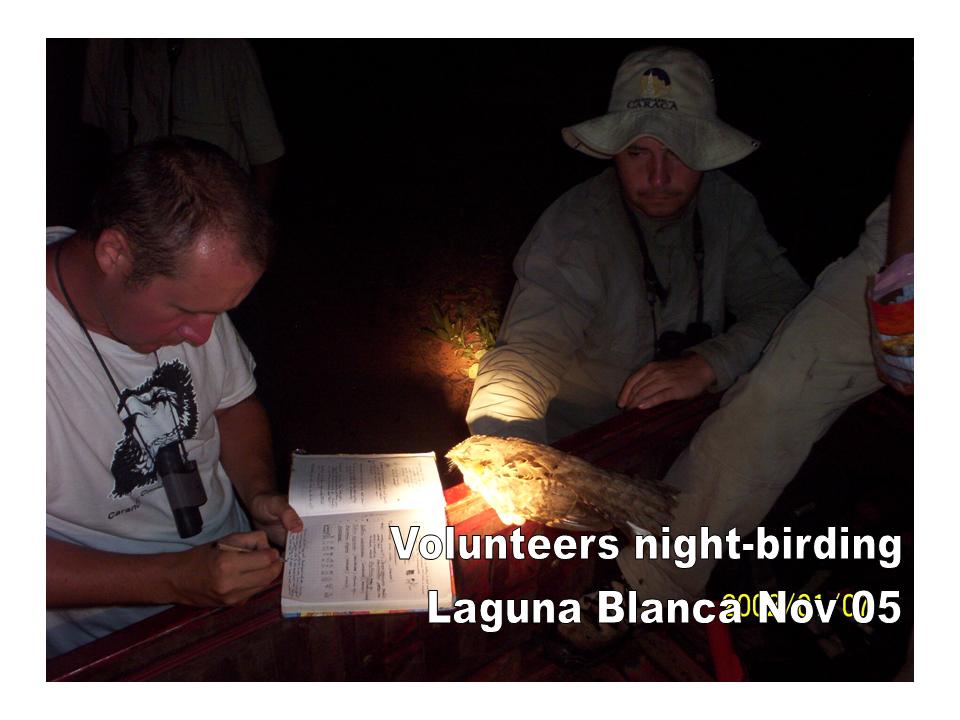
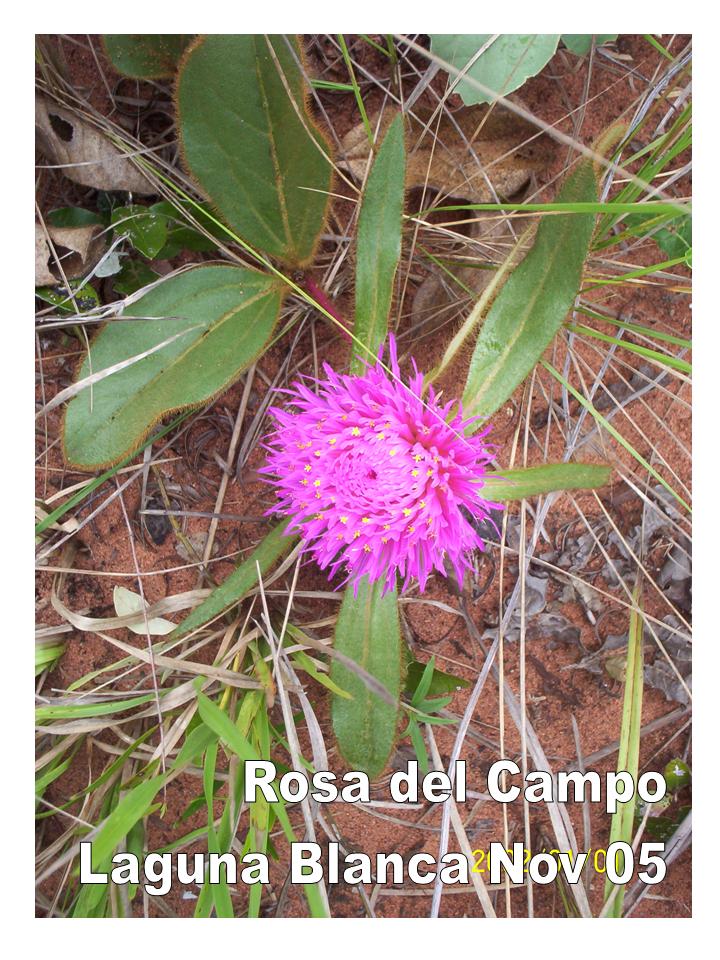
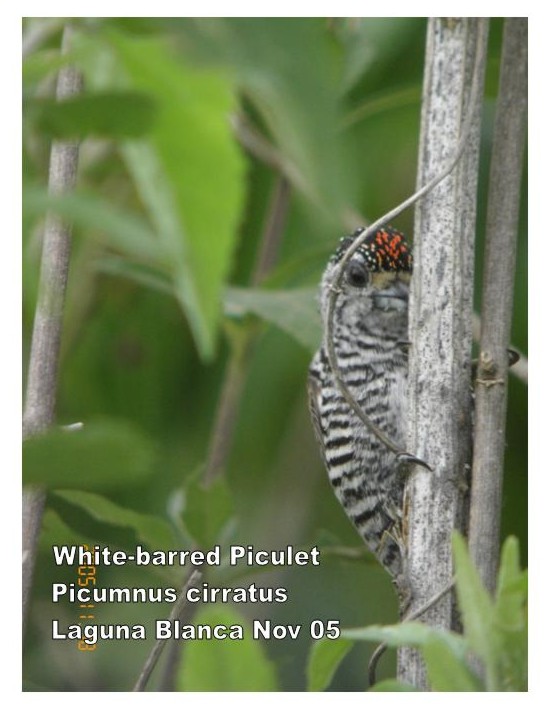
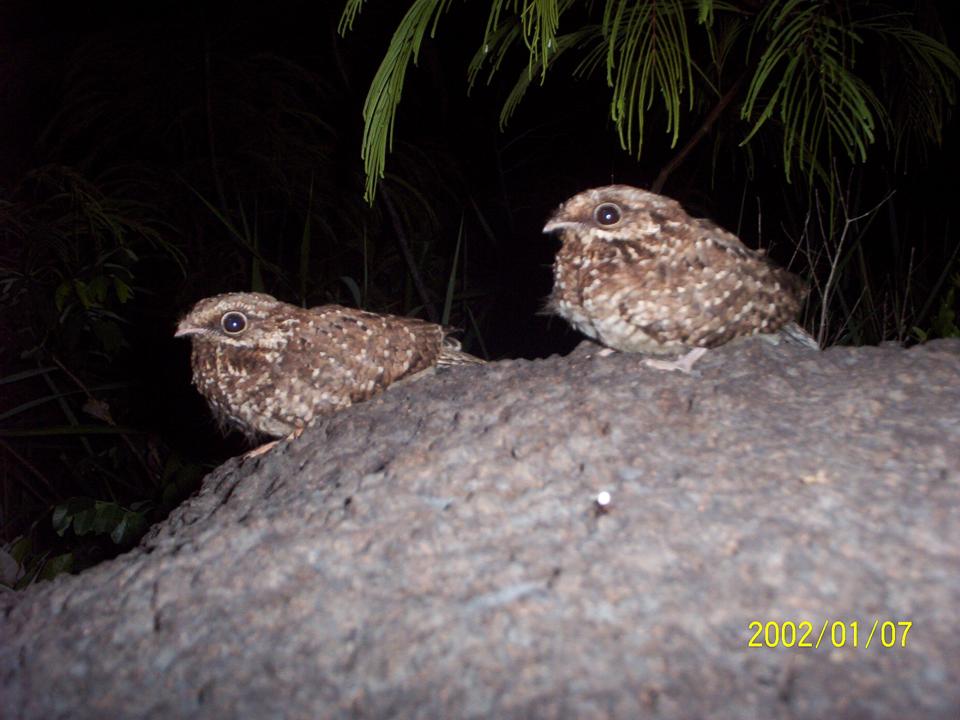
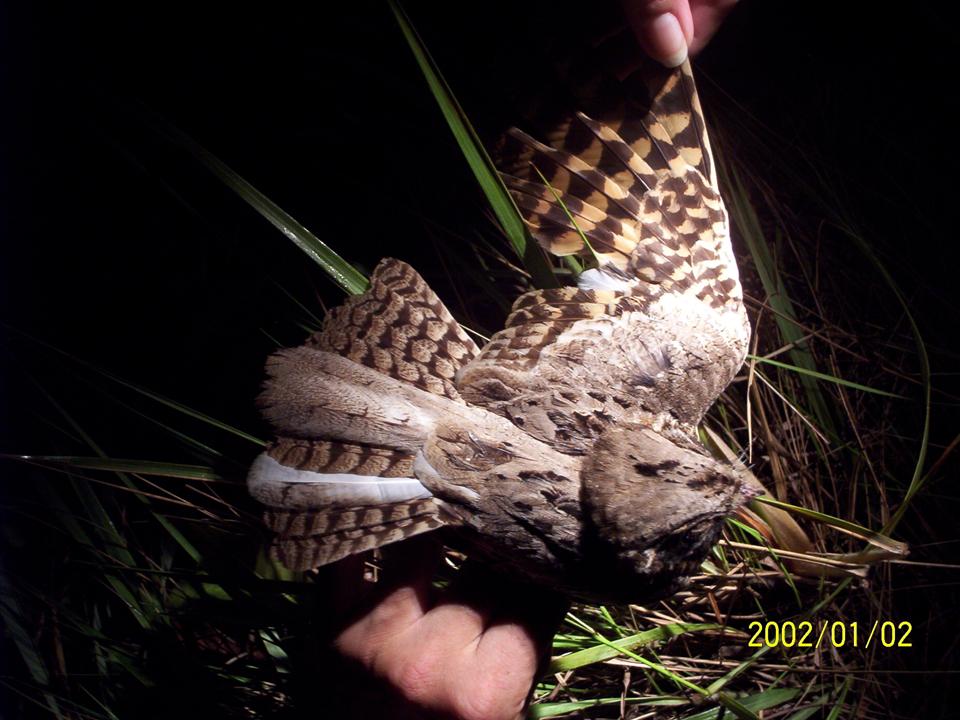
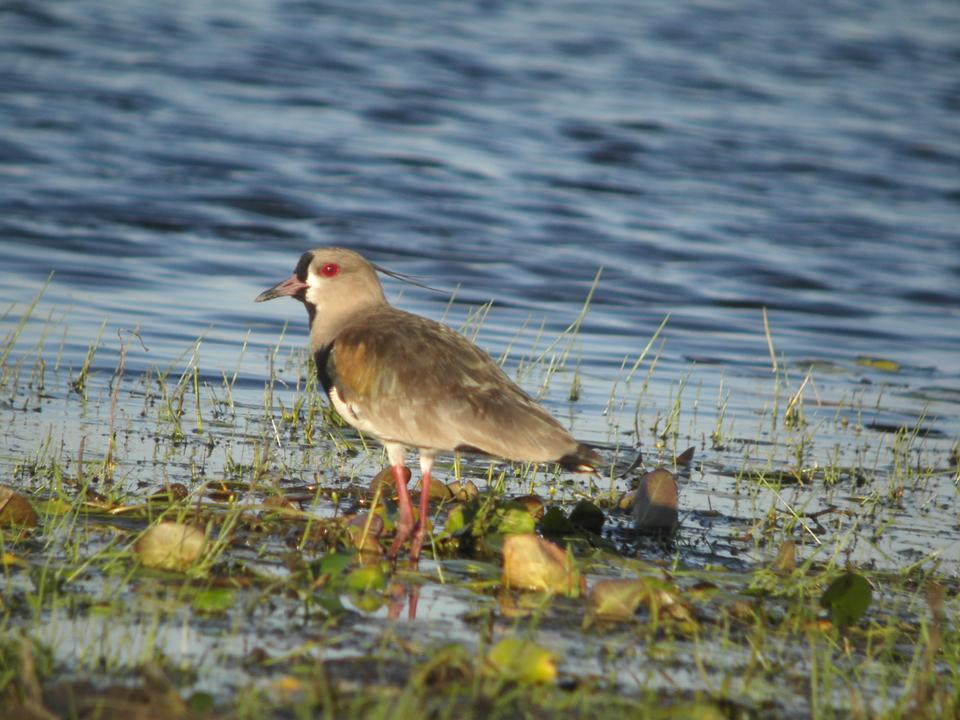
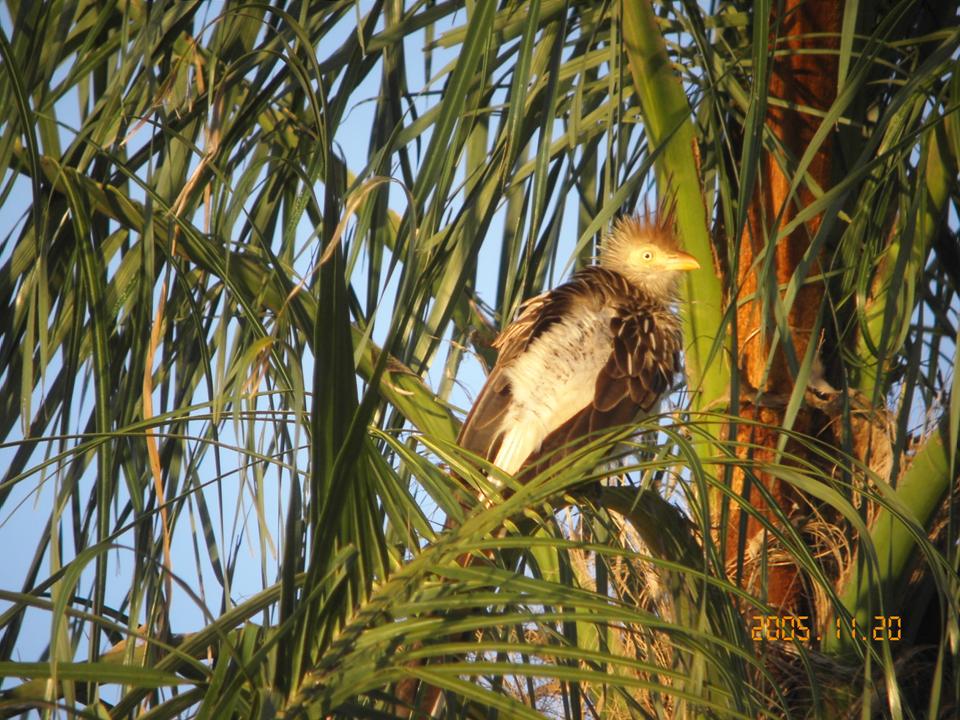
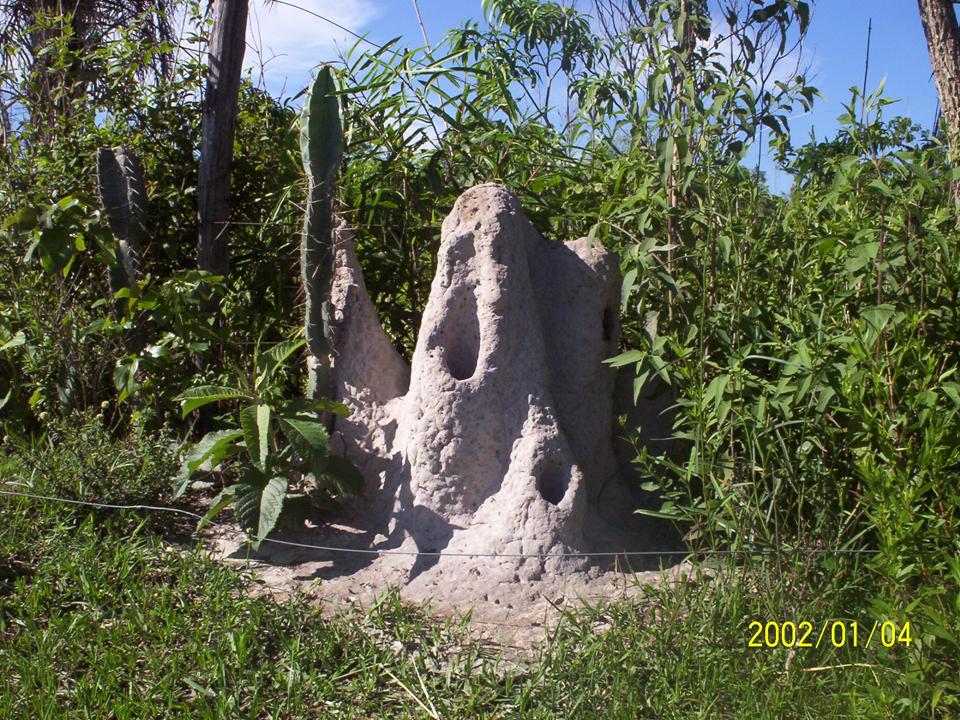
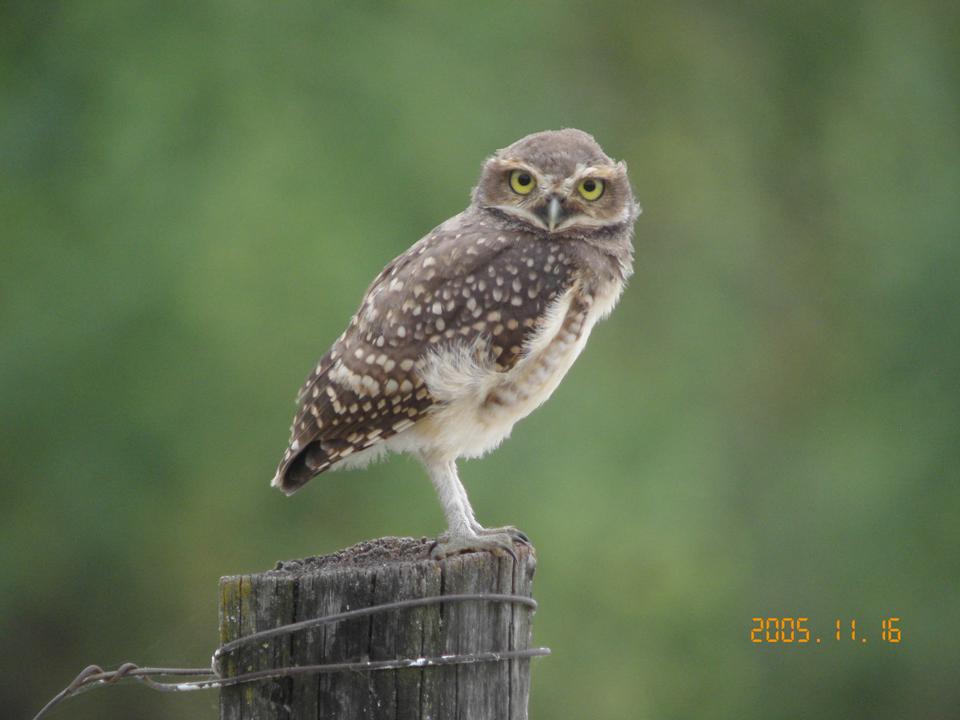

FAUNA Paraguay Technical Publication Number 2
December 2005
AN AVIFAUNAL INVENTORY OF ESTANCIA LAGUNA BLANCA,
DEPARTAMENTO SAN PEDRO, NORTH-EASTERN PARAGUAY
Paul Smith, Hugo del Castillo, Hemme Batjes, Monica Montiel and Bryan Wainwright
INTRODUCTION
The cerrado region of South America stretches historically from central Brazil through eastern Bolivia to north-eastern Paraguay, an area of approximately 1.5-1-8 million km2 (Coconier 2004). Despite disappearing at a rate comparable to the much-publicised humid forests, the cerrado is only recently receiving the conservation attention that it deserves. Currently few protected areas of cerrado exist, and in Paraguay most of the cerrado is on privately-owned estates which suffer from ineffective management and inadequate infrastructure (Coconier 2004).
Biological diversity in the cerrado region is higher than in the African savanna and endemism is high. Though the diversity of bird species is comparatively low (Ridgeley 1989) the rapid disappearance of the cerrado habitat has placed the endemic avifauna in imminent danger. Today less than 5% of the world´s cerrado remains unaltered by human activity and it is perhaps the fastest disappearing habitat on earth. In Paraguay the cerrado region is confined to the northern Orient (the east of the country), an area of approximately 16,700km2. Though the threats to the habitat are the same as in neighbouring Brazil to date much of the Paraguayan cerrado remains in relatively good condition - in part due to its unsuitability for agriculture and ranching. However as population pressure and demand for land increases, so to will the threats to the cerrado and it is important that public awareness of the value of this unique habitat be raised before it is too late.
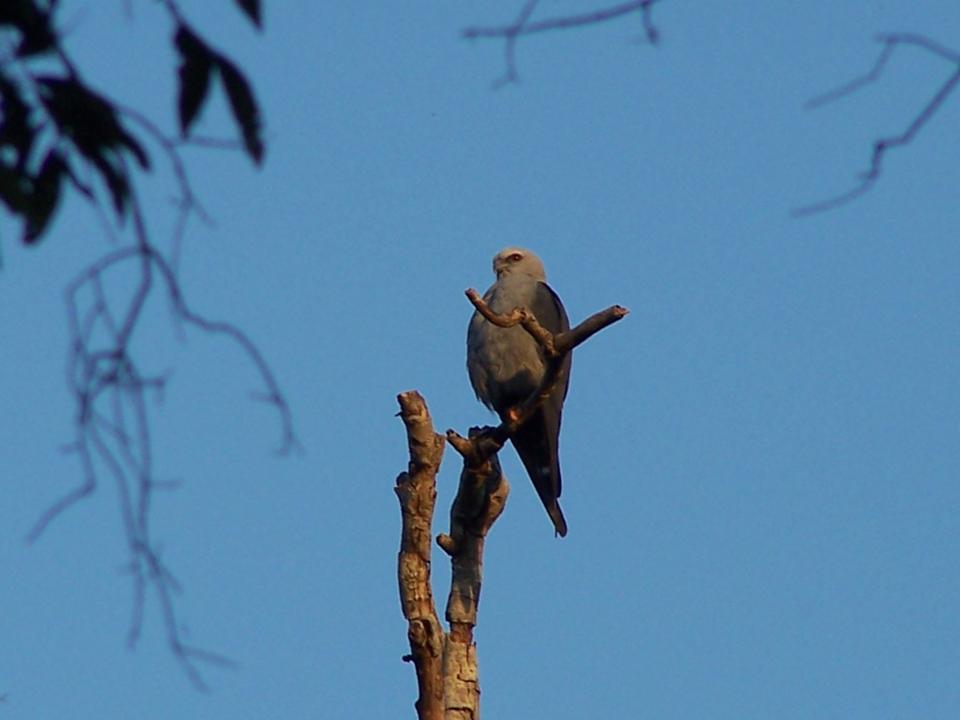
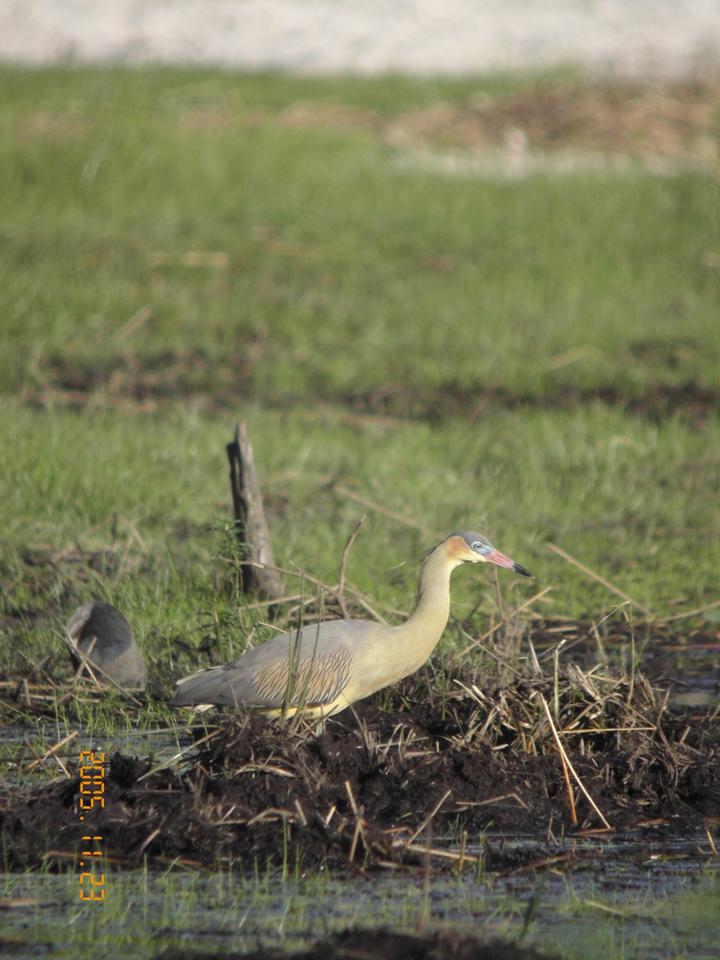
AIMS
Estancia Laguna Blanca has been periodically but unsystematically surveyed by staff of Guyra Paraguay since 1997. Amongst their most significant discoveries were healthy populations of the endangered White-winged Nightjar Eleothreptus candicans (Clay et al 1997) and vulnerable Lesser Nothura Nothura minor (Mazar Barnett et al 2004). However nearly all fieldwork conducted by Guyra has concentrated on the cerrado habitat with the other habitats being considered of lesser conservation priority. We aimed to perform a thorough species inventory of all habitats on the estancia which, in addition to records already in the Guyra Paraguay database, would help to produce a more complete species list for the site. In the process a basic bilingual field guide to the birds of the site would be produced to hopefully stimulate interest in birds and conservation amongst visitors to the estancia and highlight the uniqueness and international conservation importance of this fascinating location.
STUDY SITE
Estancia Laguna Blanca (23o48´48,37´´S, 56o17´ 43, 64´´W) is located in the District of Santa Rosa del Aguaray, Departamento San Pedro, eastern Paraguay. It has an area of 2423ha incorporating the majority of the coastline of Laguna Blanca (a true lake despite its name). In 1993 Laguna Blanca was proposed as part of a 30,000ha reserve within SINASIP (national protected areas strategy), a proposal supported by a rapid ecological survey conducted in 1997. However the resources do not exist to implement this recommendation and the area remains unprotected (Coconier 2004). Guyra Paraguay and owner Malvina Duarte have designated a small area of the property a “conservation area” (though with no official protection) and the greater Laguna Blanca area has been declared an IBA (Important Bird Area) reflecting the great ecological importance of the region.
A small area at the entrance of the Estancia has been converted to soya fields. The Atlantic forest area on the Estancia has, like that on surrounding properties, been heavily degraded. Selective logging has taken place in the past and apparently continues today. Illegal logging is also a problem and we encountered several large trunks of commercially valuable species that had been cut without the owner’s knowledge. The Atlantic forest nearest to the soya fields was at one time used for cattle ranching and has been heavily invaded by exotic grasses, impeding regeneration of native species. The densest area of Atlantic forest is in the south-west corner of the Estancia where the marshy substrate has made clearing for agriculture non-viable and the lack of established paths have restricted illegal logging attempts. At the north-west corner of the lake is a small area of dry forest with open undergrowth, separated from an area of more extensive humid forest on the northern edge of the lake by an old runway, heavily overgrown but still passable as a vehicle track. The habitat of greatest conservation interest here is the cerrado, forming the majority of the Estancia and in excellent condition. There are fine examples of each of the broad cerrado classifications - cerradón (cerrado woodland), campo sucio (cerrado grassland with scattered trees and bushes), campo limpio (true cerrado grassland) and sensu strictu (scrubby cerrado lacking in grass species). The best of the campo limpio and sensu strictu areas are towards the northern end of the Estancia, and this was where the majority of the threatened cerrado birds were most easily located.
METHODS
Fieldwork was conducted during 30 days from 27 October until 26 November 2005. Though the weather was generally fine and sunny, approximately 12 half-days of work were lost due to storms and heavy rains. We operated 4 to 7 mist nets of c44 to 73m total length at scattered sites throughout the property, their locations being rotated at approximately weekly intervals. Netting effort was concentrated in sensu strictu cerrado and cerrado-type scrub around the lake. No netting was performed in the Atlantic Forest area, this being considered of limited priority, and we netted just two mornings in campo limpio cerrado with low success rates. Netting was performed for c9hrs each day, with nets closed during periods of rain and at night. Taped recordings were used sparingly to assist in the trapping of certain species. All birds were measured upon capture (see Appendix C for measurements), their age and condition assessed, selectively photographed and released. Nightbirds were observed and captured with the aid of a powerful spotlight, hand-held torch and a hand net with a wide head diameter.
The surrounding humid forest and cerrado were surveyed by observers walking pre-existing trails. All observers had previous experience with Paraguayan birds, though for BW and HB it was their first experience of cerrado avifauna. Approximate daily counts were made for every species.
RESULTS
A total of 210 species were recorded during the course of the field work, with 41 species netted. Of the species recorded 38 were completely new for Laguna Blanca, two of these being of global conservation concern. After the completion of field work the total species list for Laguna Blanca now stands at 282. Details of the sightings of new species recorded are given below:
New Species
1.Maguari Stork Ciconia maguari - A single bird observed flying across the lake 25 Nov (BW).
2.Rosybill Netta peposaca - Flocks of 2 and 8 observed in flight over the lake on 29 and 30 Oct respectively (HB, HDC, PS, BW).
3.Masked Duck Nomonyx dominicus - A single female observed clearly as dusk was falling in flooded vegetation on the southern edge of the lake on 23 Nov (HB, PS, BW). The bird later took flight clearly exhibiting the diagnostic white wing patch.
4.Osprey Pandion haliaetus - Single birds observed flying along the edge of the lake (hunting?) on 1 and 4 Nov (HB, PS, BW).
5.Hook-billed Kite Chondrohierax uncinatus - A dark phase bird was observed soaring over the degraded humid forest on the north edge of the lake 6 Nov (HB, HDC, PS, BW). It was predominately black with noticeably rounded wings pinched in at the base and a fairly long tail that was held closed. The head, body and underwing linings were wholly black apart from a small area of white around the vent. The primaries were broadly and very clearly banded with black and white, though the secondaries appeared to be darker and greyer and unbanded (though not black). The tail was broadly banded with three black and grey bands. The supposedly elongated head silhouette of the species (Ferguson-lees 2001) was not commented upon by any observer at the time and the bird was initially tentatively identified as a Black Hawk-eagle (an extremely rare bird in Paraguay). Consultation with plates in Howell and Webb (1995) revealed that the sketches and notes made at the time closely matched the illustration and description of dark phase Hook-billed Kite.
6.Rufous-thighed Kite Harpagus diodon - A pair seen gliding across the runway from the humid forest to dry forest near the northern lake shore on 1 Nov (PS, BW, HB) and again in the same area 7 Nov (HB). A further observation of a single bird in denser humid forest near to the soya fields on 26 Nov (PS, HB, BW, HDC, MM).
7.Zone-tailed Hawk Buteo albonotatus - A single bird well-described flying across the lake observed by HB on 7 Nov. A bird that may have been this species was also seen earlier the same day in a separate location over the dry forest on the north-west side of the lake by PS, but identification could not be confirmed.
8.Purple Gallinule Porphyrio martinica - Single birds (presumably the same individual) seen on 7, 10 and 11 Nov on a small marshy pond on the south side of the lake (HB, PS, BW).
9.Azure Gallinule Porphyrio flavirostris - At least three individuals in marshy vegetation on the south side of the lake (HB, BW), one of which was photographed by HB. First record was of a single bird on 23 Nov. The birds spent most of the day hidden in dense vegetation but around 6pm became conspicuously active, perching high and flying readily above the level of the reeds.
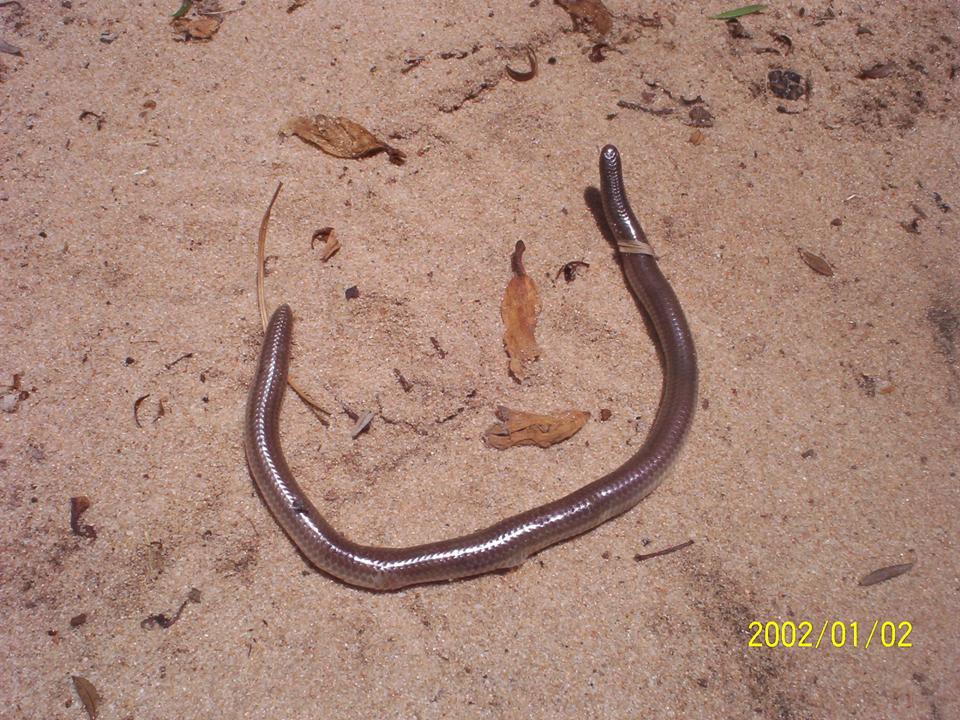
10.Greater Yellowlegs Tringa melanoleuca - Single birds observed feeding on the lakeside on 31 Oct and 18 Nov (HB, PS, BW).
11.Solitary Sandpiper Tringa solitaria - Single bird heard calling from marshy vegetation in front of the accommodation on 5 Nov (HDC, PS). This species was also later observed on an artificial water source in the nearby Paetzold property.
12.Spotted Sandpiper Actitis macularius - Single birds (presumably the same individual) seen foraging in the same area on the lakeside on 11 and 15 Nov (HB, HDC, PS, BW).
13.Upland Sandpiper Bartramia longicauda - A pair seen in the soya fields on 4 Nov (HB, HDC) represented the first records of this migrant sandpiper for the Estancia. The presence of the bird had been confirmed earlier that day by call (HDC).
14.Yellow-billed Tern Sterna superciliaris - Single birds (possibly the same individual) seen foraging around the south side of the lake on 13, 15, 17 and 24 Nov (HB, HDC, PS, BW, MM). This species is highly mobile and wanders widely, so its occurrence at the lake is no surprise.
15.Sick's Swift Chaetura meridionalis - A pair of birds seen around the lake on 28, 29 and 31 Oct and 22 Nov (HB, HDC, BW, PS).
16.Black-throated Trogon Trogon rufus - A trogon was heard calling in the humid forest near to the soya fields on 19 Nov (HB, PS, BW). The call consistently was made up of 6 or 7 notes and was noticeably more silbant than that of Surucua Trogon. Consultation with the Straneck recordings Vozes de las Aves de Argentina proved the call to be identical to the recording of Black-throated Trogon. Imitations of the calling bird failed to lure it from its hiding place.
17.Buff-bellied Puffbird Notharchus swainsoni - Single birds seen and photographed (HB) on 6 and 17 Nov (PS, BW, HB, HDC) in humid forest near to the soya.
18.Spot-backed Puffbird Nystalus maculatus - First observed on 2 Nov (BW, HB, PS) and later observed with regularity in dry forest areas and cerradón (5, 8, 10, 13, 18 Nov). This represents a southerly range extension of almost 100km for the species. The first bird was carrying a small lizard in its beak which it did not eat before flying away, suggestive of breeding.
19.Blonde-crested Woodpecker Celeus flavescens - At least 2 birds drumming loudly against thick bamboo in the humid forest area close to the soya fields on 26 Nov. A single male was observed (PS, BW, HDC, HB, MM).
20.Helmeted Woodpecker Dryocopus galeatus - The observation of a single drumming male in the dense humid forest in the south-west corner of the property on 26 Nov (PS, BW, HB, HDC, MM) was the first proof of the existence of this globally threatened species on the property. It was known to have previously occurred in the Yaguarete Forest, though the complete destruction of that forest had led to fears of local extinction. Our observation suggests that the species may not be as dependent on large areas of prime Atlantic forest as had been assumed previously, and it may be able to survive (in small numbers at least) in quite fragmented forest.
21.Robust Woodpecker Campephilus robustus - The characteristic double-drum of this species was heard on 26 Nov (PS, BW, HB, HDC, MM) in humid forest close to the soya, but the bird was not seen.
22.White-throated Woodcreeper Xiphocolaptes albicollis - A single bird heard to call and then later observed in a clearing in the humid forest close to the soya (PS, BW, HDC, HB, MM) on 26 Nov.
23.Rufous-capped Spinetail Synallaxis ruficapilla - Heard calling with regularity in thick tangles along the main track through the humid forest near to the soya. First recorded by voice on 5 Nov, with the first sighting of the bird on 15 Nov (HB, PS, BW).
24.Plain Antvireo Dysithamnus mentalis - Heard calling on 19 Nov (PS, BW, HB) in thick tangles along the main track through the humid forest near to the soya. HDC recalls having heard the species call in the same general area on previous occasions but did not make note of the dates. First sight record on 26 Nov (HB).
25.Black-capped Antwren Herpsilochmus atricapillus - A single male calling loudly and showing well in the dense humid forest in the south-east corner of the property (PS, HDC, BW, HB, MM). The species had previously been listed for the property but had been removed following doubts about the validity of the record (HDC pers. comm..)
26.Small-billed Elaenia Elaenia parvirostris - Two individuals netted and photographed on 30 Oct (PS, BW, HB) represented the first official record of the species at Laguna Blanca. PS had observed the species at Laguna Blanca during September 2004 but the record had not been reported to Guyra Paraguay. Further individuals observed and netted on 31 Oct, 1, 8 21 and 25 Nov.
27.Sepia-capped Flycatcher Leptopogon amaurocephalus - Two calling birds observed in dense forest in the south-east corner of the Estancia on 26 Nov (PS, HDC, BW, HB, MM).
28.Crowned Slaty-flycatcher Griseotyrannus aurantioatrocristatus - Two birds seen on 8 Nov (PS, HDC, BW) in tree-tops near the lake shore associating with Tropical Kingbird Tyrannus melancholicus and Fork-tailed Flycatcher T.savana represented the first record of this migrant flycatcher. Further records of a single bird on 9 Nov and two more on 22 Nov in the same general area.
29.Crested Becard Pachyramphus validus - A calling female perched conspicuously in a tree next to the ranch house was observed on 30 Oct (HDC, HB, BW, PS). Single females were later also observed in humid forest close to the soya on 6 and 16 Nov.
30.Masked Tityra Tityra semifasciata - A calling male perched conspicuously in a tree next to the ranch house was observed on 18 Nov (BW, PS). It was clearly separable from the superficially similar Black-tailed Tityra Tityra cayana by the much reduced black on the head (the crown and nape were clearly grey-white when the head was bowed) and the white tail with a dark terminal band obvious in flight and at rest.
31.Greenish Schiffornis Schiffornis virescens - A bird heard calling in the marshy forest in the south-west corner of the property on 26 Nov (HB, HDC, PS, BW). The bird was later glimpsed briefly as it flushed (HB, HDC).
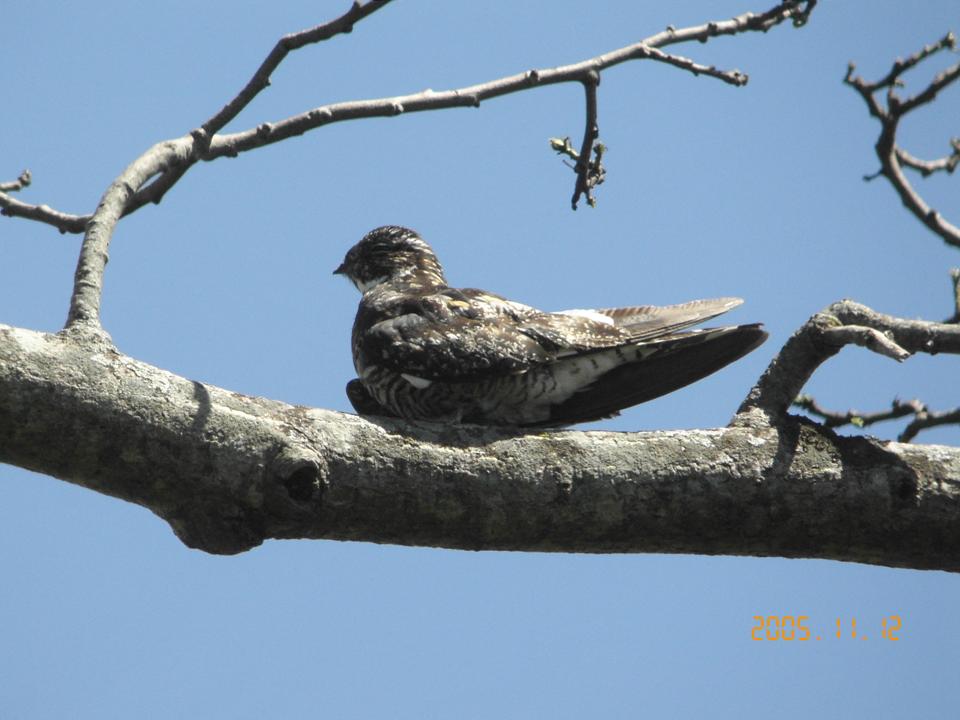
32. Red-ruffed Fruitcrow Pyroderus scutatus - A single bird feeding in a fruiting tree the humid forest near to the soya on 4 Nov (HB, BW).
33.Yellowish Pipit Anthus lutescens - Regular in the soya fields where it seems likely to be a recent coloniser. First observed 29 Oct (HDC, HB) with several further records including a peak daily count of 10 birds on 5 Nov (PS, BW, HDC, HB).
34.Flavescent Warbler Basileuterus flaveolus - A single calling bird was heard in the humid forest on the north shore of the lake on 6 Nov (HDC, MM, PS, BW, HB). One bird was observed associating with Golden-crowned Warblers Basileuterus culicivorus in a quite different area of humid forest close to the soya fields on 26 Nov (BW). The species was found to be fairly common in humid forest on surrounding properties and it is likely under-recorded at Laguna Blanca.
35.Golden-crowned Warbler Basileuterus culicivorus - Commonly heard and seen in humid forest close to the soya fields (BW, HDC, HB, PS) with the first confirmed record of two birds on 4 Nov.
36.Tawny-bellied Seedeater Sporophila hypoxantha - A pair netted and photographed on 7 Nov (PS, BW, HB). The male lost its tail during the capture process and was seen daily in a large mixed flock of seedeaters before the flock moved off following a storm on 11 Nov.
37.Marsh Seedeater Sporophila palustris - A single male of this endangered migrant seedeater was observed in a mixed seedeater flock on 9 Nov (PS, BW). Another record (possibly of the same bird) on 13 Nov (BW, HDC, Huguito Cabral).
38.Chestnut-capped Blackbird Chrysomus ruficapillus - Flock of five birds including males and females was flushed from a small marshy pond on the southern lake shore on 13 Nov (PS, BW, HB). Further records on 16, 24 and 25 Nov all refer to a single female in tall, flooded grassy vegetation on the south side of the lake, which was photographed by HB.
ECO-REGION ENDEMICS AND THREATENED SPECIES
Eleven species considered endemic to the cerrado have been recorded in Paraguay of which 4 (36%) have been recorded at Laguna Blanca. Of these eleven species it is worth noting that at least three of them are known from very few records (Dwarf Tinamou Taoniscus nanus, Campo Miner Geobates poecilopterus and Planalto Foliage-gleaner Philydor dimidiatus), while Helmeted Manakin Antilophia galeatus has recently (Jan 2006) been found very close to Laguna Blanca on a nearby property. All four cerrado endemics were recorded during the field work.
Of the three species considered endemic to the Argentinian Mesopotamian Grasslands two (66.6%) have now been recorded at Laguna Blanca, both being recorded during our field work. Most significant was the discovery of the endangered Marsh Seedeater Sporophila palustris, previously unrecorded on the property. All three AMG endemics are migrant “cappuccino” seedeaters of global conservation concern. Only the critically endangered White-collared Seedeater Sporophila zelichi remains to be recorded here but its future occurrence must be considered a possibility. Large mixed flocks of seedeaters were recorded during the project and the potential importance of Laguna Blanca for rare migratory seedeaters is something that is worth investigation.
Of the 81 Atlantic Forest endemics known from Paraguay only 20 have been recorded at Laguna Blanca (24.6%). Amongst these the discovery of the vulnerable Helmeted Woodpecker Dryocopus galeatus during our field work was of particular significance. It is worth noting that the Atlantic Forest at Laguna Blanca has not been well studied and it is likely that the number of endemics present on the property have been considerably under-recorded. We recorded 13 Atlantic Forest endemics during field work.
The number of globally threatened (10) and near threatened (4) species occurring at Estancia Laguna Blanca is extremely high considering the size of the property. Forty-seven species recorded at Laguna Blanca are of national conservation concern (See Appendix A) representing 16.6% of the total species recorded at the site. Most of the threatened and near threatened species could be found with relative ease in suitable habitat. With such a high number of species of conservation concern Laguna Blanca is of critical conservation priority both nationally and internationally.
Helmeted Woodpecker Dryocopus galeatus - The observation of a single drumming male in the dense humid forest in the south-west corner of the property on 26 Nov (PS, BW, HB, HDC, MM) was the first proof of the existence of this vulnerable species on the property. It was known to have previously occurred in the nearby Yaguarete Forest - though the complete destruction of that forest by loggers had led to fears of local extinction. Our observation suggests that the species may not be as dependent on large areas of prime Atlantic forest as had been assumed previously, and it may be able to survive (in small numbers at least) in quite fragmented habitat. Unfortunately the observation came on the last day of the project and we were unable to collect further data.
Sharp-tailed Grass-tyrant Culicivora caudacuta - A diminutive cerrado tyrant, this globally vulnerable species proved to be one of the more difficult of the threatened species to locate. Single birds were found on at least three occasions, all perching halfway down tall grass stems in campo limpio areas. On each occasion they were found in the same general area as both Black-masked Finch and Cock-tailed Tyrant though appeared to be less numerous than both. However the small size, non-vocal nature and inconspicuous habits of this species mean that it is possibly easy to overlook. It is also worth noting that the open, tall, dry grassy areas that this species prefers produce a strange optical effect on the observer when a breeze is blowing, making observation difficult despite the relatively open nature of the habitat.
Cock-tailed Tyrant Alectrurus tricolor - A single female perched prominently on the 28 Oct in a campo limpio field in the northern part of the estancia led us to a field full of displaying birds of this vulnerable species. We observed at least three males displaying for at least 4 females performing low (2 to 3m high), fluttery, horizontal “aeroplane flights” with the remarkable tail raised up over the back like the rear-end of an aircraft. Several prominent woody perches were used as start and end points for such flights and females seemed to gravitate towards these perches, encouraging the male to display more frequently. This species requires undisturbed grassland habitat (Ridgeley and Tudor 1994) and is now extinct in Argentina (Mark Pearman pers. comm.) At present it appears to be relatively frequent at Laguna Blanca and was observed on most forays into suitable campo limpio areas, however it would be extremely vulnerable to any change in the land use.
Bare-throated Bellbird Procnias nudicollis - This vulnerable cotinga was heard to vocalise daily from patches of humid forest but was not observed within the boundaries of the Estancia. A group of three or more singing males were observed closely on the nearby Paezold property (which is currently being heavily logged). The population in the area appears to be healthy but the vocal nature of this species may give an artificially high impression of numbers. The heavy logging pressure in San Pedro Department will undoubtedly lead to a severe decline in the population of this and other Atlantic Forest species in the area. There has also been a recent increase in trapping of this species for the pet trade in Paraguay (BirdLife International 2004)
White-banded Tanager Neothraupis fasciata - Common and conspicuous in sensu strictu cerrado and denser campo sucio. Family groups of up to eight individuals of this near threatened species were observed on a daily basis, some feeding recently fledged juveniles. Juvenile birds were wholly buffy-brown, lacking the face mask but with a hint of a white malar streak. The upperwing coverts were black with small white spots and the bill and legs pale pinkish. We have been unable to find any description of this plumage in the literature. The description of the presence of several subadult birds (essentially patterned as adults but browner) in every family group mentioned by Ridgeley and Tudor (1989) accurately matches our observations. Foraging is mainly on the ground or low in vegetation with a single adult bird perching prominently on a high bush and alarm calling an abrupt BIT at the approach of an observer. Such calling encourages all group members to rise to low, semi-conspicuous perches and adopt alert postures (often accompanied by muted calling). This species was initially netted using playback of the song (which has an oddly hirundine-like quality), the “sentinel” male reacting rapidly and aggressively to a taped recording placed next to a net. Distress calls of netted individuals also attracted other family members close to (and often into!) the net.
Black-masked Finch Coryphaspiza melanotis - Singing males of this vulnerable species were located in open campo limpio with tall dry grass - the same as that favoured by Sharp-tailed Grass-tyrant. Males perch low, but relatively prominently to sing though the indistinct single sireep notes produced are difficult to locate and insect-like. It is also worth bearing in mind that certain quiet tik calls of the abundant Wedge-tailed Grassfinch Emberizoides herbicola could potentially be mistaken for the song of this species.
Marsh Seedeater Sporophila palustris - A single male of this endangered migrant seedeater was observed in a mixed seedeater flock on 9 Nov (PS, BW) with another record (possibly of the same bird) on 13 Nov (BW, HDC, Huguito Cabral). The flock was dominated by Double-collared Seedeater S.coerulescens and Blue-black Grassquit Volatinia jacarina with small numbers of other species present. These are the first records of this species at Laguna Blanca.
Chestnut Seedeater Sporophila cinnamomea - A single male of this vulnerable migrant seedeater was observed in the same mixed seedeater flock as S.palustris on 9 Nov (BW). Previous records suggest that this species is an annual passage migrant in small numbers at Laguna Blanca.
Dark-throated Seedeater Sporophila ruficollis - Recorded fairly regularly with mixed seedeating flocks with a maximum of two males of this near-threatened migrant seedeater seen together on any one occasion (PS, BW, HDC, HB). A lone male of this species was also observed some 5km outside the study site in a marshy area. The species was previous only known from a single record at Laguna Blanca (MM)
SPECIES COMPOSITION
The soya fields near the entrance to the Estancia are predictably of little interest. For the most part they are inhabited by large flocks of Blue-black Grassquit Volatinia jacarina and large numbers of Grassland Sparrow Ammodramus humeralis. That said two species new to the Estancia list were found only in the soya, Yellowish Pipit Anthus lutescens and Upland Sandpiper Bartramia longicauda. Both are likely recent invaders capitalizing on the new habitat created by the soya farmers.
As previously mentioned most of the Estancia´s Atlantic forest is in a sorry state. Mixed flocks were occasionally encountered and key species seemed to be Hooded Tanager Nemosia pileata, Blue Dacnis Dacnis cayana, Purple-throated Euphonia Euphonia chlorotica and Grey Elaenia Myiopagis caniceps. In general activity in the Atlantic forest area was extremely low, but a large number of species new to the reserve list were recorded along the main path - most fairly standard inhabitants of Atlantic Forest in Paraguay such as Golden-crowned Warbler Basileuterus culicivorus, Plain Antvireo Dysithamnus mentalis and Rufus-capped Spinetail Synallaxis ruficapillus. They are likely to have been previously unrecorded due to lack of observer effort in the humid forest areas of the Estancia. The discovery of Sooty-fronted Spinetail Synallaxis frontalis in degraded scrub further along the forest track is notable. This is a common bird of “junk” habitats throughout Paraguay but is usually from humid forest. Its presence here is likely a recent colonization, the species taking advantage of heavy deforestation of the surroundings to expand its range. The forest in the south-west corner of the Estancia is in much better condition and it was here that one of the most significant finds of the project took place, the discovery of a single male Helmeted Woodpecker Dryocopus galeatus. Unfortunately this find was made on the last day of the project and so further observations were not possible. Other species of considerable note included Masked Tityra Tityra semifasciata, Red-ruffed Fruitcrow Pyroderus scutatus, Buff-bellied Puffbird Notharchus swainsonii and Black-throated Trogon Trogon rufus.
The most significant component of the scrubby habitats around the south and west sides of the lake was the large flocks of migrant seedeaters feeding in tall seeding grass. Amongst them were several threatened “cappuccino” seedeaters including the first record of the endangered Marsh Seedeater Sporophila palustris and an additional record of the vulnerable Chestnut Seedeater Sporophila cinnamomea. These flocks were dominated by Double-collared Seedeaters Sporophila caerulescens, Red-crested Finches Coryphospingus cucullatus and Blue-black Grassquits Volatinia jacarina. Other notable elements of the avifauna of this scrubby habitat were the large numbers of Dark-billed Cuckoos Coccyzus melocoryphus surprisingly bold and easy to observe, while Rusty-backed Antwrens Formicivora rufa were found to be faithful to the same small areas of scrub where they could be easily located by voice.
Psittacids were encountered daily in large numbers. Typically the most numerous species were Yellow-chevroned Parakeet Brotogeris chiriri and Reddish-bellied Parakeet Pyrrhura frontalis which often formed large, noisy flocks. Turquoise-fronted Amazon Amazona aestiva were seen flying to and from their roost above the lake in pairs or small flocks most mornings and evenings. Peach-fronted Parakeet Aratinga aurea seems to be more strictly associated with the open campo sucio cerrado and cerradón and despite our observation of a flock of 16 on the 29 Oct it was not encountered with any regularity. Scaly-headed Parrot Pionus maximilliani, Pileated Parrot Pionopsitta pileata and White-eyed Parakeet Aratinga leucopthalmus were recorded fairly regularly in small numbers.
In the area immediately around the ranch house is a nesting colony of vocal Chopi Blackbirds Gnorimopsar chopi while Tropical Kingbird Tyrannus melancholicus and Fork-tailed Flycatcher T.savana hawked from the tall trees in the camping area. Several columbids were also conspicuous in this area, most notably Scaled Dove Scardafella squamata. Estancia Laguna Blanca is one of the few places in Paraguay where this species can be easily seen. Other species recorded regularly in this general area were Little Woodpecker Veniliornis passerinus, Pale-breasted Thrush Turdus leucomelas, Gilded Hummingbird Hylocharis chrysura and Great Kiskadee Pitangus sulphuratus.
The flooded grassy areas around the southern edge of the lake produced some interesting records. Ash-throated Crake Porzana albicollis appeared to be fairly numerous based on voice records, but perhaps the most interesting discovery was of Azure Gallinule Porphyrula flavirostris. This migrant species is considered rare in this region (Central Paraguay) by Clay and del Castillo (2004) but we observed at least 3 individuals. Around 6pm each day they became more active and would participate in short pursuit (?) flights above the level of the vegetation that rendered them easy to observe. For the rest of the day they could not be located in the dense vegetation.
The lagoon in general seems to be poor in bird species. Striated Heron Butorides striatus and Whistling Heron Syrigma sibilatrix are the commonest ardeids, other species being recorded only occasionally in small numbers. Ducks are extremely uncommon, though we added two species to the list Rosybill Netta peposaca and the secretive Masked Duck Nomonyx dominicus. The lagoon does not appear to be of much importance for migrating waders. We recorded just 4 species of migrant waders on the lagoon shore despite fieldwork taking place during the peak of the migration season, and none were in any real numbers. Indeed the only bird species that seems to use the lagoon on a regular basis is Neotropic Cormorant Phalacrocorax brasilianus.
Tinamous were heard calling daily, typically Undulated Tinamou Crypturellus undulatus preferring the dry forest areas and Tataupa C.tataupa in more humid areas. Small-billed Tinamou C.parvirostris seemed to show no preference for either dry or humid areas and was even seen in quite open situations in the cerrado. The dry forest was not surveyed in detail but on the few forays made appeared to be poor in bird numbers and diversity. Typical species included Rufous Casiornis Casiornis rufa, Southern Beardless Tyrannulet Camptostoma obsoletum and Purplish Jay Cyanocorax cyanomelas, as well as several species of Elaenia. One significant find in the dry forest was the discovery of Spot-backed Puffbird Nystalus maculatus, representing a considerable southerly range extension over what was previously known.
From a conservation point of view much the most important part of the Estancia is the cerrado. Typical species of sensu strictu and campo sucio areas included White-banded Tanager Neothraupis fasciata and Black-throated Saltator Saltator atricollis, both species apparently acting as sentinels for others, perching prominently and alarm calling at the approach of an observer. In areas with trees these species were joined by Suiriri Flycatcher Suiriri suiriri, White-rumped Monjita Xolmis velata and White-rumped Tanager Cypsnagra hirundinacea. Curl-crested Jay Cyanocorax cristatellus seemed to be the most significant inhabitant of islands of cerradón, and was vocal and conspicuous where present. Wedge-tailed Grassfinch Emberizoides herbicola and Pale-breasted Spinetail Synallaxis albescens were abundant in campo sucio areas but less numerous in sensu strictu.
In areas of true campo limpio in the north of the Estancia most of the more important species were located, often in fairly close association - notably Sharp-tailed Grass-tyrant Culicivora caudacuta, Black-masked Finch Coryphaspiza melanotis and Cock-tailed Tyrant Alectrurus tricolor. None of these species were vocal (Black-masked Finch giving only a weak wheezy call) but all perched fairly conspicuously on grass stems. Red-legged Seriema Cariama cristata could be heard throughout the Estancia during most of the day, though sight records were few. Of the cerrado tinamous Red-winged Tinamou Rhynchotus rufescens was the commonest and most widespread, while Lesser Nothura Nothura minor seems to prefer grassy areas of campo sucio near to bushy islands. Spotted Nothura Nothura maculata did not appear to be numerous, despite being generally the commonest open country tinamou in Paraguay.
We recorded 17 species of raptor during fieldwork, 4 of which were new for the site list. Aplomado Falcon Falco femoralis, American Kestrel Falco sparverius, Roadside Hawk Buteo magnirostris and White-tailed Hawk Buteo albicaudatus were generally the most numerous species in the cerrado. Large flocks of Swallow-tailed Kite Elanoides forficatus and Snail Kite Rostrhamus sociabilis were also recorded, presumably birds on passage. In forested areas Plumbeous Kite Ictinia plumbea was the most frequently recorded species.
Nightbirding produced particularly impressive results. Pauraque Nyctidromus albicollis, Rufous Nightjar Caprimulgus rufus, Little Nightjar C.parvulus, Grey Potoo Nyctibius griseus and Tropical Screech-owl Megascops choliba were all heard to vocalise on most nights and were seen with regularity. In the cerrado Scissor-tailed Nightjar Hydropsalis torquata and Little Nightjar seemed to prefer campo sucio habitats at the edge of forested areas and both were seen to regularly perch on roads. The endangered White-winged Nightjar Eleothreptus candicans was easy to find, though showed a distinct affiliation for open sensu strictu areas with a ground covering of Pouteria. Birds perched prominently on low twigs within a metre of the ground and were recognizable even from a distance by their “big-eyed, big-headed” jizz. One specimen of Chestnut-banded Nighthawk Lurocalis nattereri was seen to depart nightly from a roost in a tree adjacent to the ranch house and was joined by a second bird from further afield shortly after dusk. The species could be encouraged to fly quite close to observers by imitation of their call shortly after they departed from the roost.
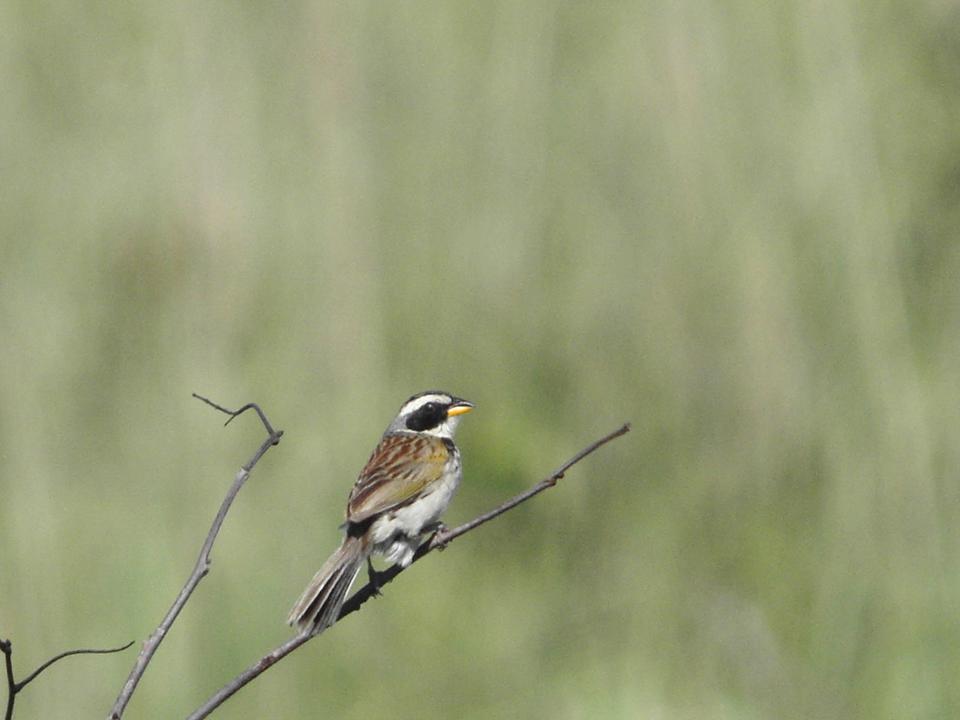
FURTHER OBSERVATIONS OF INTEREST
Evidence of breeding was found in the following species Southern Lapwing Vanellus chilensis (nest with young), Ruddy Ground-dove Columbina talpacoti (nest), White-winged Nightjar Eleothreptus candicans (chicks - see below), Spot-backed Puffbird Nystalus maculatus (food-carrying), Surucua Trogon Trogon surrucura (nest), Belted Kingfisher Ceryle torquata (food-carrying), Yellow-chinned Spinetail Certhiaxis cinnamomea (nest), Great Kiskadee Pitangus sulphuratus (nest), Social Flycatcher Myiozetetes similes (nest), Grey-breasted Martin Progne chalybea (nest), White-banded Tanager Neothraupis fasciata (adults feeding recently fledged young), Grassland Sparrow Ammodramus humeralis (nest) and Chopi Blackbird Gnorimopsar chopi (nest). The following species were seen displaying and breeding is suspected but could not be confirmed - Cock-tailed Tyrant Alectrurus tricolor, Blue-black Grassquit Volatinia jacarina and Screaming Cowbird Molothrus rufoaxillaris. Just outside of the study area a Red-legged Seriema Cariama cristata was found sitting on a nest and Streamer-tailed Tyrants Gubernetes yetapa were seen displaying at Arroyo Clementina.
The following mammals were recorded during fieldwork - Tamandua Tamandua tetradactyla; Tayra Eira Barbara; Crab-eating Fox Cercodyon thous; Collared Peccary Tayassu tajacu; Grey Brocket Deer Mazama gouaziboura; Brown Capuchin Cebus capella; Coypu Myoscastor coypus; Azara’s Agouti Dasyprocta azarae; Brown Rat Rattus norvegicus, and Brazilian Rabbit Sylvilagus brasiianus. The following species were captured Yellow Armadillo Euphractus sexcinctus, Dwarf Dog-faced Bat Molossops temmincki, and Chaco Rice-rat Oligoryzomys chacoensis. Presence of Puma Felis concolor and Maned Wolf Chyrsocyon brevicaudatus were confirmed by prints and the latter also by its characteristic “vomit”. Reptiles recorded included Four-toed Whiptail Lizard Teius teyou and a dead Worm Snake Leptotyphlops sp. apparently killed, but not eaten by a Burrowing Owl.
THREATS
The most imminent threat facing Estancia Laguna Blanca is that the cerrado area has recently been rented by a Brazilian cattle rancher who intends to graze 500+ head of cattle on it. The sandy soils on which cerrado habitats grow are notoriously poor for farming and considered of low quality for ranching so the rental price is accordingly low, despite the biological importance of the area. He has already cleared two large areas of campo sucio to construct “runways” of undetermined function. Trampling by cattle is likely to have severe effects on ground-nesting species (including the White-winged Nightjar Eleothreptus candicans), but perhaps more serious is the possible burning and planting of aggressive exotic grasses to create pasture. These grasses grow rapidly, easily out-competing the native cerrado vegetation.
The humid forest areas on the property are already degraded, though some good quality forest remains in the south-west corner of the estancia (apparently protected by the marshy substrate that makes it unsuitable for farming). The major threats to the forest are the illegal logging of valuable tree species, clearing for farming and burning (the effects of a severe fire in 2003 are still visible in many areas while a large area near the entrance of the estancia has already been cleared for soya). Much of the humid forests in the surrounding area have already been heavily logged (the Yaguarete Forest has completely disappeared) and tree species of secondary quality are now being removed.
A less visible threat is pollution and run-off of toxic chemicals used in the intensive farming of surrounding properties (notably by the Mennonite communities). The porous nature of the sandy soils in the area means that chemicals rapidly seep towards the drinkable, freshwater Laguna Blanca, poisoning this valuable water source (Coconier 2004).
CONCLUDING REMARKS
With ecotourism still in its infancy in Paraguay travel for independent birders can be difficult. This has led to Paraguay becoming something of a “forgotten corner” of South America, despite having a species list that compares more than favourably with similar-sized areas of neighbouring countries. With international attention diverted elsewhere, the plight of the Paraguayan cerrado and its other endangered habitat types has gone somewhat unnoticed by both the local population and the international birding community.
The sustainable development of tourism is something which the Paraguayan government is just waking up to, though private landowners in general still do not see it as a means of generating income that would compete with farming or ranching. That said Estancia Laguna Blanca’s rustic accommodation and attractive surroundings would seem ideally suited to tourism. The white sand beach and lake will appeal to weekend tourists in this landlocked country, while the impressive naturaleza and large number of globally threatened and near threatened bird species should qualify the site as one of the most important in South America. The main problems are those of access (a 4WD vehicle is needed to negotiate the dirt tracks leading to the estancia) and publicity (few people outside of the Paraguayan birding community have even heard of the site!). Owner Malvina Duarte has recently set up a website in an attempt to attract more visitors to the Estancia (www.lagunablanca.com.py).
Through the production of the Laguna Blanca mini guide, and subsequent titles in the “Where to Watch Birds in Paraguay” series we hope to raise interest and awareness amongst locals, landowners, birders and biologists in the rich but imminently threatened “naturaleza” of Paraguay and to assist in some small way the conservation of important, but hitherto unprotected sites with eco-touristic potential.
REFERENCES
BirdLife International 2004 - Threatened Birds of the World 2004 CD-Rom.
Brooks TM, Tobias J, Balmford A 1999 - Deforestation and Bird Extinctions in the Atlantic Forest - Animal Conservation 2: p211-222.
Coconier EG 2004 - Project Conservation of the Paraguayan Cerrado - Guyra Paraguay
Clay RP, Capper DR, Mazar Barnett J, Burfield IJ, Esquivel EZ, Fariña R, Kennedy CP, Perrens M, Pople RG 1998 - White-winged Nightjar Caprimulgus candicans and Cerrado Conservation: The Key Findings of Project Aguara Ñu 1997 - Cotinga 9: p52-56.
Clay RP, del Castillo H 2004 - Annotated Checklist of the Birds of Paraguay - Guyra Paraguay.
Clay RP, Lopez-Lanus B, Tobias JA, Lowen JC, Mazar Barnett J 2000 - The Display of the White-winged Nightjar - Journal of Field Ornithology 71: p619-626.
Emmons LH, Feer F 1999 - Mamíferos de los Bosques Húmedos de América Tropical: Una Guía de Campo - Editorial FAN.
Ferguson-Lees J, Christie DA 2001 - Raptors of the World - Helm.
Galindo-Leal C, Camara IG 2003 - The Atlantic Forest of South America: Biodiversity Status, Threats and Outlook - Island Press.
Hayes FE 1995 - Status, Distribution and Biogeography of the Birds of Paraguay - American Birding Association.
Howell, Webb 1995 - A Guide to the Birds of Mexico and Northern South America - OUP
Mazar Barnett J, Klavins J, del Castillo H, Coconier E, Clay R 2004 - Nothura minor (Tinamidae) A Globally Threatened Cerrado Species New to Paraguay - Ararajuba 12: p55-57.
Redford KH, Eisenberg JF 1992 - Mammals of the Neotropics Volume 2 The Southern Cone: Chile, Argentina, Uruguay and Paraguay - University of Chicago Press.
Ridgeley RS, Tudor G 1989 - The Birds of South America Vol 1: The Oscine Passerines - Oxford University Press.
Smith P, Clay RP in press - A Field Guide to the Birds of Paraguay - Helm
Velázquez M, Clay R 2002 - Informe Técnico Estancia Laguna Blanca - Guyra Paraguay

Designed by Paul Smith 2006. This website is copyrighted by law.
Material contained herewith may not be used without the prior written permission of FAUNA Paraguay.
Photographs on this web-site were taken by Paul Smith, Hemme Batjes, Regis Nossent,
Alberto Esquivel, Arne Lesterhuis, Rebecca Zarza and Hugo del Castillo and are used with their permission.
OBSERVATIONS OF THREATENED SPECIES
We recorded all globally threatened species except for Crowned Eagle Harpyhaliaetus coronatus and all near threatened species except for Bearded Tachuri Polystictus pectoralis. Below we give brief details of our observations of the species of conservation concern.
Greater Rhea Rhea americana -Groups of up to seven individuals of this near threatened species were recorded in campo limpio and open campo sucio areas. It was most often encountered in the northern extremities of the Estancia, though fieldwork during 2004 recorded them much closer to the lake. It seems likely that the population is small but stable (provided illegal hunting can be prevented) and the scattering of footprints suggests that they are liable to local wandering.
Lesser Nothura Nothura minor - In concurrence with Mazar Barnett et al (2004) we found this vulnerable species to be locally common in raised areas of campo sucio adjacent to more open grassy areas. However, where Mazar Barnett et al (2004) states that the birds rarely vocalise during the morning we found that sporadic vocalisation would take place throughout the day, often eliciting a response from nearby conspecifics. The dusk chorus of this species was a constant feature of the late afternoon in suitable areas, with a maximum of 5 birds taking part. Calls had a distant quality that made the source difficult to trace and several birds were flushed from almost underfoot before they could be located. Only on one occasion did we succeed in getting close to a calling bird. The bird stopped calling as we approached and crouched low in a patch of bare sandy ground with scattered clumps of grasses. It was detected only because if performed a brief “head-bob” sufficient to catch the attention of MM. The bird was approached to within two metres, remaining motionless and making no attempt to flee, but an attempt to catch the bird with a hand net was unsuccessful. The species is hunted locally but the major threat to this species in the area would seem to be unmanaged burning of the cerrado for conversion into pasture land. Though natural fires are an almost annual occurrence in the cerrado, this species is said to avoid recently burnt land (Collar 1992) and uncontrolled fires could have a devastating effect on the population.
White-winged Nightjar Eleothreptus candicans - This endangered nightjar, known from only three permanent localities on earth (two of which are in Paraguay) has an estimated population of 20-50 pairs at Laguna Blanca. The species was located with relative ease on night drives and showed a distinct affinity for sensu strictu cerrado dominated by the low-growing shrub Pouteria. Even from a distance its “large-headed, large-eyed, short-tailed” jizz and lazy, tilting flight style are diagnostic. Several individuals were captured and measured, including a immature male bird that closely resembled the adult female apart from its greyer (as opposed to brownish) overall colouration. The bird could be sexed due to the presence of a pure white secondary on the left wing in the early stages of growth and a white inner web to T3 on the right side of the tail.
On 10 Nov we found a pair of chicks perched on a low termite mound approximately 30cm high and 60cm in diameter. They were immediately identifiable as White-winged Nightjar because they already possessed the diagnostic head pattern of adult birds and the characteristic jizz of the species. Both birds were similar in plumage, predominately rufous-brown with a broad white malar and greyish supercilium. They were spotted buff and barred black on the upper breast and appeared to be somewhat paler and whiter on the belly. The upperparts were mostly rufous-brown, flecked liberally with buff (especially on the wings) and black. The crown was centrally brown (blacker on the rear crown), with the grey of the supercilium extending up onto the sides (more conspicuously in one bird than the other). Neither bird showed any white on the wings or tail. If approached too closely the birds would scuttle crablike a few centimetres sideways with rapid movements of the pinkish feet, but at no stage did they leave the termite mound. They showed no sign of alarm and did not crouch or utter any sound, suggesting that their only form of defence is their cryptic colouration - which closely matched the colour of the termite mound on which they were perched. None of the group of birds involved in the encounter described above approached the chicks at any stage, so we are unable to confirm whether that behaviour was associated with their proximity.
